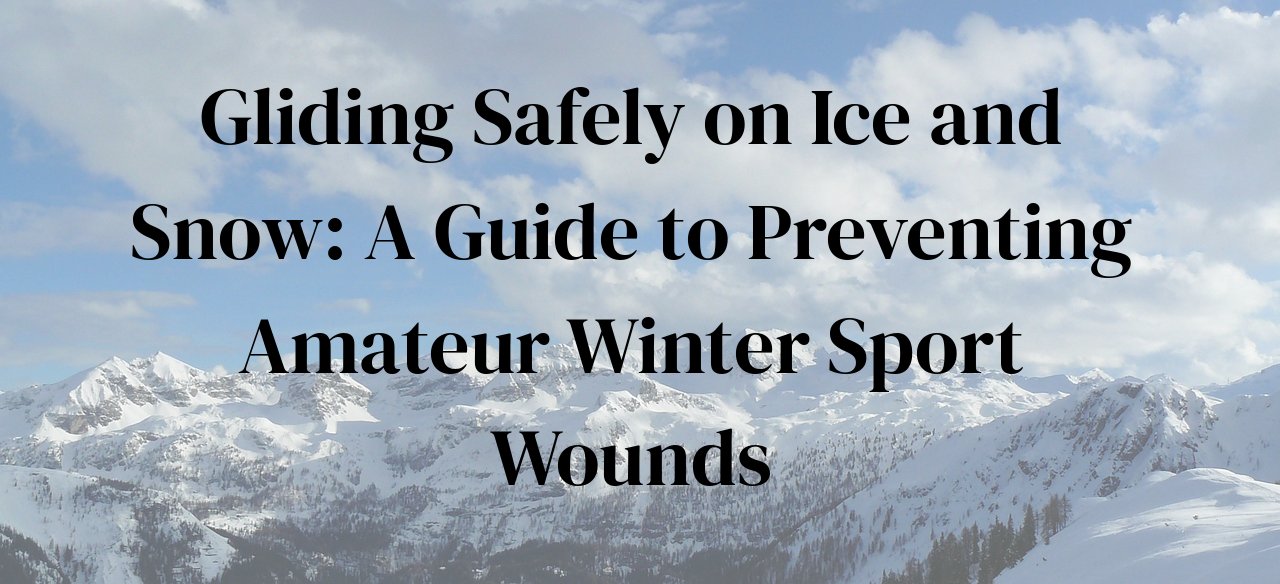
As the mercury dips and pristine snow blankets the landscapes, many are enticed by the thrill of winter sports. Yet, with the rush of the cold wind comes the potential for injuries that could leave lasting impacts. In this piece, we’ll delve into the overlooked hazards that amateur athletes face in the colder months and explore effective strategies to shield oneself from harm. By the end of this blog post, not only will you gain insights into the intricacies of winter sports injuries, but you’ll also be armed with practical prevention techniques to keep your winter escapades safe and enjoyable.
Table of Contents
Understanding the Terrain: Hidden Dangers in Winter Sports
The sparkling allure of freshly fallen snow and the exhilarating promise of a wide-open ice rink can easily obscure the risks lurking within winter sports terrains. Amateur enthusiasts might glide into the season with zest, but an awareness of the potential perils beneath the frosty surface is crucial for a safe sporting experience.
One of the less obvious threats is variable snow conditions. What appears to be a smooth slope could be a deceptive veil over ice patches, hidden rocks, or unstable snowpacks that increase the risk of falls and collisions. It’s essential to learn about the day’s snow conditions before venturing out, ideally seeking advice from local authorities or resort staff who are familiar with the nuances of the terrain.
Tree wells, those insidious hollows that form around the bases of trees, represent another hidden danger. Skiers or snowboarders who unwittingly veer too close can tumble in and become trapped, leading to potentially serious situations. Staying on marked trails and maintaining a safe distance from tree lines are prudent precautions for navigating these natural traps.
When it comes to ice, the perils can be just as covert. Frozen lakes and ponds may invite skaters with their glassy surfaces, but the integrity of the ice is often inconsistent. The potential for falling through into icy waters is a stark reality, necessitating a thorough check of ice thickness and a wariness of venturing onto suspect frozen expanses.
Unmarked obstacles such as rocks, branches, or remnants of earlier human activity might lie hidden under the pristine white and cause unexpected trips or twists. A mindful approach when plotting one’s course can mitigate some of these risks. Similarly, awareness of avalanche-prone areas is crucial for sports like backcountry skiing or snowshoeing, where the untouched wilderness beckons the adventurous spirit but also harbors latent threats such as sudden snowslides.
By embracing a balance of excitement and caution, enthusiasts of winter sports can relish the thrills while respecting the caprices of nature’s winter canvas. The glittering terrain, for all its magnificence, demands a thoughtful approach to safeguard against the hidden dangers it holds.
Beyond the Common Cold: Internal Risks of Winter Activities
Engaging in winter sports is thrilling, but we often underestimate the internal risks that come with such activities, which go far beyond catching the common cold. One lesser-known hazard is hypothermia, which can ensue when the body loses heat faster than it can produce it, leading to a dangerous drop in core temperature. This can happen even without falling into icy waters; inadequate clothing and failing to recognize the early shivers can turn a day on the slopes into a chilling ordeal.
Musculoskeletal injuries also fall under the internal risks of winter activities. The strain of maneuvering snowy terrains can lead to unexpected sprains, as muscles and joints react differently in cold conditions. They are less flexible, more prone to injury, and recovery can be painstakingly slow due to the decreased blood flow in cold environments.
Another risk to consider is altitude sickness, particularly for those who venture into high mountainous regions for skiing or snowboarding. This can manifest through symptoms such as headaches, nausea, and dizziness, which are often mistaken for less serious ailments. In the high altitudes where air is thinner, our bodies may struggle to acclimatize, leading to diminished performance and potentially severe health complications if not addressed promptly.
Cardiovascular events should not be ignored when discussing internal risks. The combination of cold temperature, strenuous exercise, and high altitude can significantly increase the workload on the heart. Those with underlying heart conditions, or even those who are unaware of any issues, might face risks such as a heart attack triggered by the sudden exertion and environmental stress.
Winsome wonderlands of winter often veil the perilous possibility of frostbite, which inflicts damage to skin and tissues, potentially resulting in long-term harm. Novices may not recognize the numbness associated with frostbite, brushing it off as a minor nuisance, whereas it necessitates swift medical attention. Therefore, understanding and recognizing the signs of these less obvious internal winter sport risks can immensely enhance one’s safety and enjoyment.
Gear Up Properly: Choosing the Right Protection
Delving into the world of winter sports requires not only enthusiasm but also a strategic approach to selecting the equipment that will shield you from harm’s way. Protection in winter sports isn’t solely about warmth; it’s about crafting a barrier against the unpredictable elements and potential impacts unique to icy terrains.
Firstly, helmets are an absolute must, and not just any helmet, but one specifically designed for winter sports. Helmets for skiing or snowboarding, for instance, are constructed to withstand multiple low-force impacts typical of these sports. They often contain insulation for warmth and vents for breathability, striking a balance between protection and comfort.
When it comes to your vision on the slopes, goggles are indispensable. They serve a two-fold purpose – safeguarding your eyes from harmful UV rays reflected by the snow and improving visibility during various conditions like snowfall or fog. High-quality, anti-fogging lenses are a critical feature to prevent vision impairment that could lead to accidents.
Your hands are prone to cold and injuries, and that’s where gloves come into play. Choose gloves with ample insulation, waterproofing, and dexterity so that you can maneuver your equipment with ease while keeping frostbite and cold burns at bay.
Body armor and padding might sound excessive to the uninformed, but for enthusiasts venturing into extreme sports or terrain parks, they are a lifeline. Look for back protectors, padded shorts, wrist guards, and even knee pads. These items are designed to absorb shock and protect against fractures or sprains during falls or collisions.
Lastly, a proper pair of boots is foundational. They should not only keep your feet dry and warm but also provide support to your ankles and a firm grip on slippery surfaces. For sports like ice climbing, boots must have compatibility with crampons for secure attachment.
While gearing up can seem like a hefty investment, remember, these tools serve as your personal guardians against the harsh realities of winter sports. Embrace the season’s thrills with respect, and dress to safeguard your adventures.
Training Techniques: Preparing Your Body for the Chill
Embracing the frosty joy of winter sports necessitates more than mere enthusiasm; it demands a tailored approach to physical preparation. It’s crucial to acknowledge that cold-weather activities place unique demands on the body. As such, adapting your training regimen to address these factors can substantially mitigate the risk of injuries.
Initiate your journey with ‘Dynamic Warm-Ups’. Unlike their static counterpart, these exercises elevate your core temperature and enhance muscular flexibility. Incorporating movements akin to your chosen sport, be it lunges for skiers or arm swings for ice hockey players, prepares your muscles for intense activity.
Proceed to ‘Muscular Endurance and Strength Training’. The relentless conditions of winter sports often require sustained muscular contractions. Incorporate exercises such as squats and deadlifts for lower body strength, crucial for stabilizing knees and preventing ACL injuries, alongside planks and rotational exercises to fortify your core, providing the stability needed to navigate treacherous terrain.
‘Balance and Proprioception Workouts’ deserve attention, as uneven ice and slippery slopes pose a formidable challenge. Employ balance boards or perform single-leg exercises to develop proprioception, which in turn, reduces the risk of falls and sprains.
Focusing on ‘Cardiovascular Conditioning’ is imperative for endurance. In the biting cold, your heart works harder to distribute blood. Engage in interval training or cross-country skiing to enhance your cardiac resilience and oxygen utilization. This level of preparedness transcends physical benefits, instilling a sense of confidence that allows for more relaxed and responsive movements.
Lastly, ‘Flexibility and Mobility Exercises’ are your unsung heroes in the combat against strains and sprains. Yoga or Pilates routines fine-tune your range of motion, crucial when you find yourself in unpredictable scenarios on the icy expanse.
Remember, the essence of these training techniques lies in gradual progression and consistency. Rushing or skimping establishes a fertile ground for injuries. With these strategies, your body will not only be prepared for the chill but also be poised to revel in the exhilaration of winter sports with a robust defence against potential wounds.
Navigating Emergency Situations: What If Injury Strikes?
When gliding across the frosty terrain, the crisp air filling your lungs, it’s easy to forget the lurking risks of winter sports. Enthusiastic amateurs often fall prey to unexpected emergencies; thus, knowing how to navigate through such situations is as vital as the sport itself. In the unfortunate event that an injury occurs, remaining calm and immediately assessing the severity of the situation is paramount. An essential step is to carry a well-equipped first aid kit, tailored for cold-weather accidents including items such as bandages, splints, and thermal blankets to provide immediate assistance and prevent further harm.
Contacting emergency services without delay can be the difference between rapid recovery and long-term complications. In areas with poor cell service, it’s advised to have a pre-arranged signaling method or alternative communication device. Members of the group should be knowledgeable about their exact location to expedite rescue efforts. While waiting for help, keeping the injured party warm and stable is crucial to forestall hyperthermia and shock, conditions that can swiftly escalate in icy environments.
Should a participant suffer from a twist, sprain, or potential fracture, immobilize the affected area, and refrain from applying direct heat, as this can complicate swellings. For head injuries, even if consciousness is retained, encourage minimal movement and constant monitoring, since symptoms can grow progressively worse without immediate medical attention.
If an injury seems minor, it’s tempting to ‘push through the pain’; however, this mindset can aggravate the injury and lead to more significant issues. Substituting instead a more nurturing approach, like applying the RICE (Rest, Ice, Compression, Elevation) method, will serve an amateur athlete better in the long haul. And if in doubt, always opt for professional medical assessment over self-judgment.
Ultimately, it’s the collective responsibility of all participants to familiarize themselves with basic emergency procedures. Participating in a first aid course specific to winter sports, prior to the commencement of the snowy season can equip athletes with life-saving skills. As they say, ‘An ounce of prevention is worth a pound of cure’. And in the wintery expanse, this can’t ring truer, for when injury strikes, the right knowledge can keep a chilling situation from turning cold.
Conclusion
In our conquest to conquer the slopes and rinks, precaution is our most trusted ally. Winter sports, while exhilarating, can pose unique and lesser-known threats to our well-being. With a deeper awareness of these risks and an arsenal of prevention tactics, amateurs can look forward to a season of sport that’s not just about the thrill, but about coming home healthy, too. Embrace these preventative measures and make this winter sports season your safest yet.



